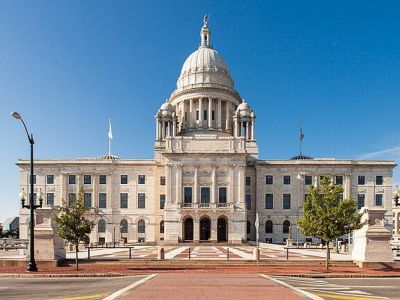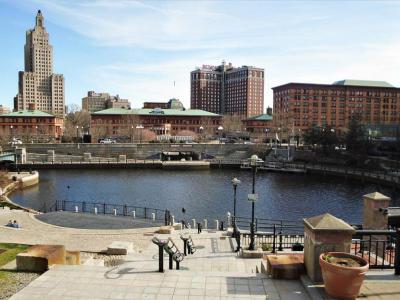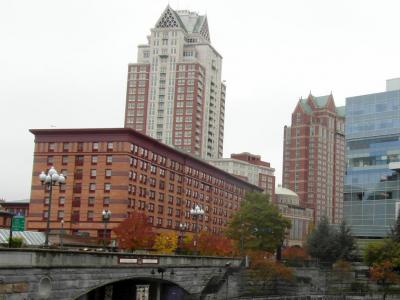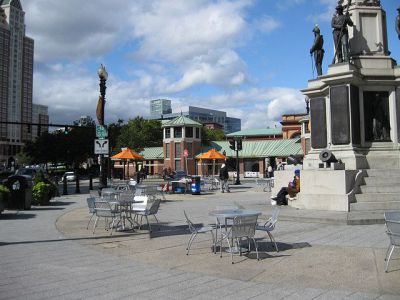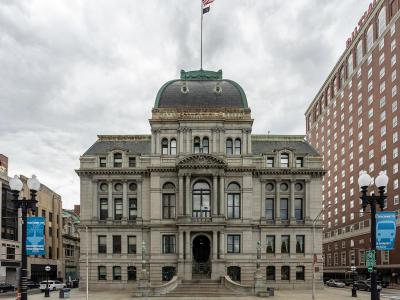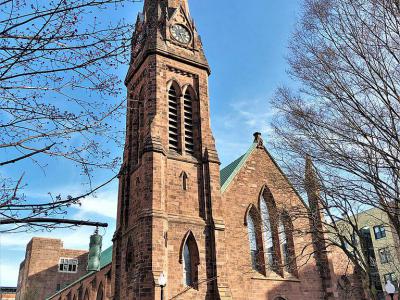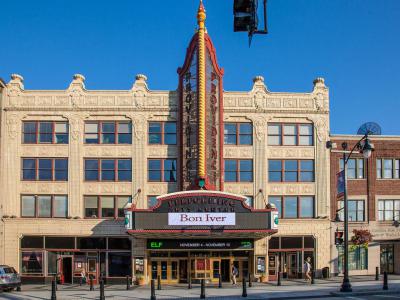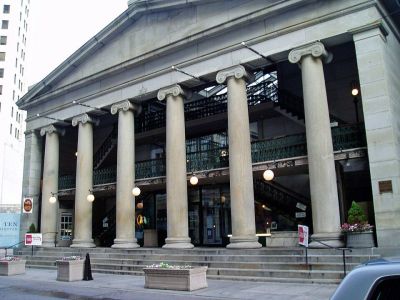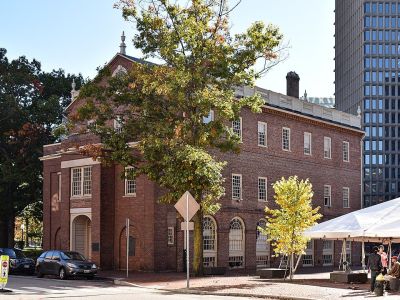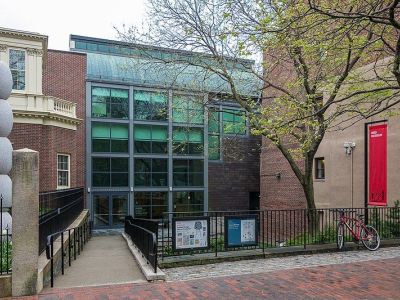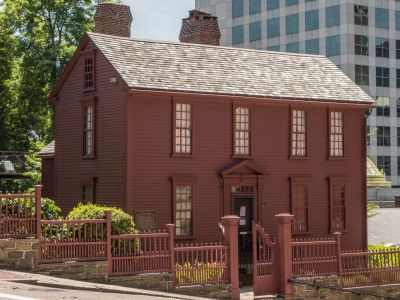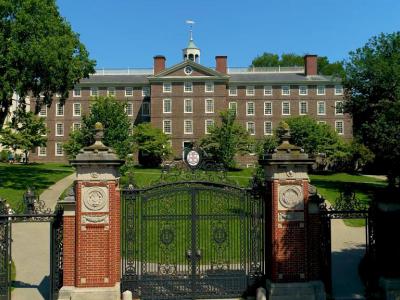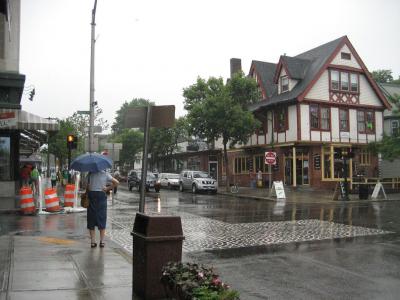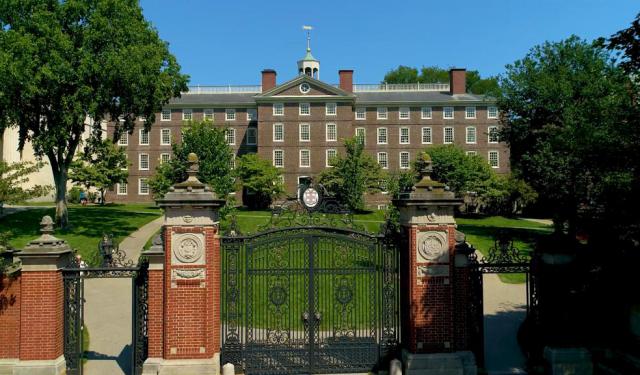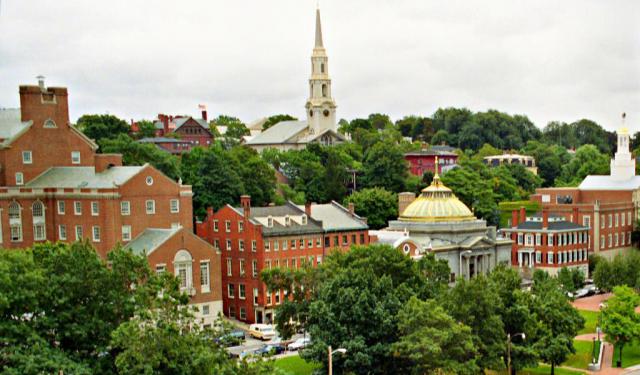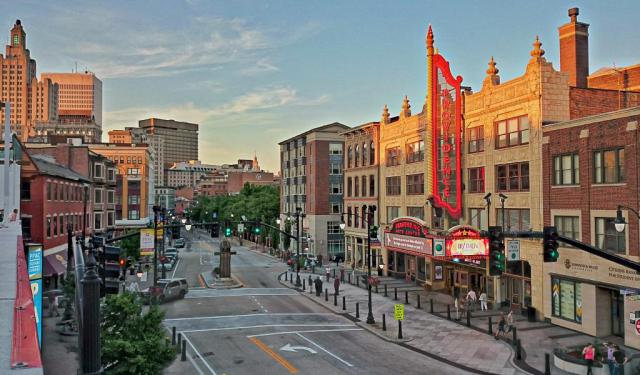
Providence Introduction Walking Tour (Self Guided), Providence
Providence, the capital of the US state of Rhode Island, is one of the oldest cities in New England. Founded in 1636 by the Puritan theologian Roger Williams, it was one of the original Thirteen Colonies that formed the United States. The settlement was named after "God's merciful Providence" which Williams believed was responsible for revealing such a haven for him and his followers.
Over the next two decades, despite challenging farming conditions and border disputes with neighboring Connecticut and Massachusetts, Providence expanded into a self-sufficient agricultural and fishing community. The city's 1652 prohibition of indentured servitude beyond 10 years marked the first anti-slavery law in the US, despite which, however, the local merchants actively participated in the slave trade that turned Providence into a major port by the early 1700s.
In 1770, Brown University – a high-profile, Ivy League educational institution – moved to Providence, thus symbolizing its commercial and political dominance over the colony. In 1772, the Gaspee Affair, in which a group of locals burned a British customs schooner, marked the earliest armed resistance to British rule in America, preceding the Boston Tea Party.
In 1831, Providence ratified a city charter, leading to the establishment of city government headquarters in the Market House until 1878, when Providence City Hall became the new permanent municipal building.
During the American Civil War, Providence significantly contributed to the Union's efforts, leading to its post-war prosperity and a substantial increase in population due to waves of immigration.
By the start of the 20th century, Providence hosted some of the largest manufacturing centers in the country, producing steam engines, precision tools, silverware, screws, and textiles. This brought advancements in infrastructure, particularly in the form of rail travel. In addition, an influx of money allowed significant architectural feats to be achieved, such as the Rhode Island State House completed in 1901.
The making of jewelry – emerged as a dominant local industry during the 1960s – earned Providence the moniker “the jewelry capital of the world.” The arts have long been important in Providence, too. Those visiting will see places like the Providence Performing Arts Center, Westminster Arcade, and the Rhode Island School of Design Museum as proof of the enduring legacy of art and theater in Rhode Island.
Whether you're a history enthusiast, art aficionado, or simply seeking a memorable urban adventure, Providence invites you to explore its rich tapestry of culture and heritage. Our self-guided tour provides a good vehicle for that!
Over the next two decades, despite challenging farming conditions and border disputes with neighboring Connecticut and Massachusetts, Providence expanded into a self-sufficient agricultural and fishing community. The city's 1652 prohibition of indentured servitude beyond 10 years marked the first anti-slavery law in the US, despite which, however, the local merchants actively participated in the slave trade that turned Providence into a major port by the early 1700s.
In 1770, Brown University – a high-profile, Ivy League educational institution – moved to Providence, thus symbolizing its commercial and political dominance over the colony. In 1772, the Gaspee Affair, in which a group of locals burned a British customs schooner, marked the earliest armed resistance to British rule in America, preceding the Boston Tea Party.
In 1831, Providence ratified a city charter, leading to the establishment of city government headquarters in the Market House until 1878, when Providence City Hall became the new permanent municipal building.
During the American Civil War, Providence significantly contributed to the Union's efforts, leading to its post-war prosperity and a substantial increase in population due to waves of immigration.
By the start of the 20th century, Providence hosted some of the largest manufacturing centers in the country, producing steam engines, precision tools, silverware, screws, and textiles. This brought advancements in infrastructure, particularly in the form of rail travel. In addition, an influx of money allowed significant architectural feats to be achieved, such as the Rhode Island State House completed in 1901.
The making of jewelry – emerged as a dominant local industry during the 1960s – earned Providence the moniker “the jewelry capital of the world.” The arts have long been important in Providence, too. Those visiting will see places like the Providence Performing Arts Center, Westminster Arcade, and the Rhode Island School of Design Museum as proof of the enduring legacy of art and theater in Rhode Island.
Whether you're a history enthusiast, art aficionado, or simply seeking a memorable urban adventure, Providence invites you to explore its rich tapestry of culture and heritage. Our self-guided tour provides a good vehicle for that!
How it works: Download the app "GPSmyCity: Walks in 1K+ Cities" from Apple App Store or Google Play Store to your mobile phone or tablet. The app turns your mobile device into a personal tour guide and its built-in GPS navigation functions guide you from one tour stop to next. The app works offline, so no data plan is needed when traveling abroad.
Providence Introduction Walking Tour Map
Guide Name: Providence Introduction Walking Tour
Guide Location: USA » Providence (See other walking tours in Providence)
Guide Type: Self-guided Walking Tour (Sightseeing)
# of Attractions: 13
Tour Duration: 2 Hour(s)
Travel Distance: 3.9 Km or 2.4 Miles
Author: alice
Sight(s) Featured in This Guide:
Guide Location: USA » Providence (See other walking tours in Providence)
Guide Type: Self-guided Walking Tour (Sightseeing)
# of Attractions: 13
Tour Duration: 2 Hour(s)
Travel Distance: 3.9 Km or 2.4 Miles
Author: alice
Sight(s) Featured in This Guide:
- Rhode Island State House
- Water Place Park
- Providence Place
- Kennedy Plaza
- Providence City Hall
- Grace Church
- Providence Performing Arts Center
- Westminster Arcade
- Market House
- Rhode Island School of Design Museum
- Governor Stephen Hopkins House
- Brown University
- Thayer Street
1) Rhode Island State House (must see)
The Rhode Island State House is the state capitol of Rhode Island. The neoclassical building was designed by McKim, Mead & White in 1891. Construction completed on the building in 1901. It is built from white Georgia marble, bricks and iron beams.
The Rhode Island State House is notable for having the fourth largest structural-dome in the world. The dome, modeled after St. Peter's basilica, is topped with a statue called "The Independent Man." The gilded bronze statue was designed by George Brewster in 1899. It is 11 feet tall and weighs more than 500 pounds.
Visitors to the State House will find the Rhode Island Charter Museum inside. The museum displays the 1663 Royal Charter among its historical document collection. Visitors will also see Gilbert Stuart's portrait of George Washington and a number of military displays.
The building was placed on the National Register of Historic Places in 1970. It is open from 8:30 AM to 4:30 PM Monday through Friday.
The Rhode Island State House is notable for having the fourth largest structural-dome in the world. The dome, modeled after St. Peter's basilica, is topped with a statue called "The Independent Man." The gilded bronze statue was designed by George Brewster in 1899. It is 11 feet tall and weighs more than 500 pounds.
Visitors to the State House will find the Rhode Island Charter Museum inside. The museum displays the 1663 Royal Charter among its historical document collection. Visitors will also see Gilbert Stuart's portrait of George Washington and a number of military displays.
The building was placed on the National Register of Historic Places in 1970. It is open from 8:30 AM to 4:30 PM Monday through Friday.
2) Water Place Park (must see)
Water Place Park is an urban park in downtown Providence. It gets its name from its location near the Woonasquatucket River.
The park rests at the foot of the Rhode Island State House. It is characterized by foot-bridges inspired by Venice. In addition, there are a number of activities that take place at Water Place Park. Some of these include the Convergence art festival, the Summer Concert series and the WaterFire exhibit that appears in the water on select evenings throughout the year.
The park, completed in 1994, rests on the original site of the Great Salt Cove. The water of the cove was drained and land filled to allow railroad tracks to meet the needs of the city. When the rails were no longer needed, the River Relocation Project allowed for the creation of Water Place Park and vibrant area that surrounds it.
Water Place Park is well known for public art displays. There are also a wide number of artists who spend their days gaining inspiration for their work. The park is open 24 hours.
The park rests at the foot of the Rhode Island State House. It is characterized by foot-bridges inspired by Venice. In addition, there are a number of activities that take place at Water Place Park. Some of these include the Convergence art festival, the Summer Concert series and the WaterFire exhibit that appears in the water on select evenings throughout the year.
The park, completed in 1994, rests on the original site of the Great Salt Cove. The water of the cove was drained and land filled to allow railroad tracks to meet the needs of the city. When the rails were no longer needed, the River Relocation Project allowed for the creation of Water Place Park and vibrant area that surrounds it.
Water Place Park is well known for public art displays. There are also a wide number of artists who spend their days gaining inspiration for their work. The park is open 24 hours.
3) Providence Place
Providence Place is the largest shopping mall in Rhode Island. It opened in 1999 with original anchor stores Lord & Taylor's, Nordstrom and Filene's. Current anchor stores at Providence Place are Boscov's and Macy's.
It is a 1.4 million sq ft space designed by architect Friedrich St. Florian. After initial pushback from nearby residents, the mall was redesigned to more closely reflect the neighborhood. In addition, the red and yellow brick turrets were added as an homage to the industry of Providence.
The mall consists of three floors of shopping areas and street level restaurants. Along with numerous stores and restaurants, Providence Place has a 16-screen cinema and an IMAX theatre. One of the most stunning features of the mall is the Winter Garden, which is a four-level structure with glass views of the city.
Most of the shops within Providence Place are chain boutiques like Spencer's, Abercombie & Fitch, GameStop and Sephora. The mall also hosts special events like holiday gatherings, entertainment and adult education. Providence Place is opens at 11 AM daily. The mall closes at 6 PM on Sundays, 7 PM Monday through Thursday and 8 PM on Fridays and Saturdays.
It is a 1.4 million sq ft space designed by architect Friedrich St. Florian. After initial pushback from nearby residents, the mall was redesigned to more closely reflect the neighborhood. In addition, the red and yellow brick turrets were added as an homage to the industry of Providence.
The mall consists of three floors of shopping areas and street level restaurants. Along with numerous stores and restaurants, Providence Place has a 16-screen cinema and an IMAX theatre. One of the most stunning features of the mall is the Winter Garden, which is a four-level structure with glass views of the city.
Most of the shops within Providence Place are chain boutiques like Spencer's, Abercombie & Fitch, GameStop and Sephora. The mall also hosts special events like holiday gatherings, entertainment and adult education. Providence Place is opens at 11 AM daily. The mall closes at 6 PM on Sundays, 7 PM Monday through Thursday and 8 PM on Fridays and Saturdays.
4) Kennedy Plaza
Kennedy Plaza is a public square in downtown Providence. The square is surrounded by some of the city's most important buildings, such as City Hall, the Federal Building and the John O. Pastore Federal Building. Burnside Park and Union Station are also nearby.
Prior to its creation, the area was part of the Great Salt Cove estuary. It was filled in to create a rail yard and terminal in 1846. Unfortunately, a fire burned the large building in 1896 and the spot was turned into City Hall Park.
The square was renamed to Kennedy Plaza after John F. Kennedy was assassinated in 1963. Thirty years later, the mayor of Providence redesigned the square into a central bus depot. It has been stated that the square has been renovated more than any other spot in the city.
Today, the plaza is a pedestrian-friendly area that remains rife with history. The bus stops and benches that proliferate Kennedy Place were once a spot where presidents like Theodore Roosevelt and Woodrow Wilson delivered speeches to the nation. It was where Gen. Ambrose Burnside readied his troops for war. John F. Kennedy gave his last speech as presidential candidate in the plaza.
Kennedy Place is also known for its public art. The 1871 Soldiers' and Sailors' Monument was created by Randolph Rogers and Alfred E. Stone. The Hiker, sculpted in 1911, was designed by Theo Alice Ruggles Kitson. There is also an equestrian statue of Burnside, designed by Launt Thompson in 1887.
Prior to its creation, the area was part of the Great Salt Cove estuary. It was filled in to create a rail yard and terminal in 1846. Unfortunately, a fire burned the large building in 1896 and the spot was turned into City Hall Park.
The square was renamed to Kennedy Plaza after John F. Kennedy was assassinated in 1963. Thirty years later, the mayor of Providence redesigned the square into a central bus depot. It has been stated that the square has been renovated more than any other spot in the city.
Today, the plaza is a pedestrian-friendly area that remains rife with history. The bus stops and benches that proliferate Kennedy Place were once a spot where presidents like Theodore Roosevelt and Woodrow Wilson delivered speeches to the nation. It was where Gen. Ambrose Burnside readied his troops for war. John F. Kennedy gave his last speech as presidential candidate in the plaza.
Kennedy Place is also known for its public art. The 1871 Soldiers' and Sailors' Monument was created by Randolph Rogers and Alfred E. Stone. The Hiker, sculpted in 1911, was designed by Theo Alice Ruggles Kitson. There is also an equestrian statue of Burnside, designed by Launt Thompson in 1887.
5) Providence City Hall
Providence City Hall is the municipal government building. It remains the location of such government offices as the Voter Registration office, City Registrar and Department of Vital Statistics. It is also open for self-guided, public tours.
Construction of the building began in 1875 and was completed in 1878. It was designed by Samuel J.F. Thayer in the Second Empire architectural style. The building is made of cast iron, masonry and granite. The first of its five public floors was built five feet above street level in order to protect against flooding, though there is now a street-level entrance accessible to the general public.
The Gallery at City Hall is on the second floor of the building. It showcases work from local artists with monthly exhibits. Student art is regularly displayed in this gallery.
The building fell into disrepair and was slated for demolition until a plan was put into place to restore the building to its former glory. Historians Antoinette Downing, Frank Mauran III and Irving B. Haynes led the restoration work, which began in 1975 and was completed in the 1990s. Providence City Hall was added to the National Register of Historic Places in 1975.
Construction of the building began in 1875 and was completed in 1878. It was designed by Samuel J.F. Thayer in the Second Empire architectural style. The building is made of cast iron, masonry and granite. The first of its five public floors was built five feet above street level in order to protect against flooding, though there is now a street-level entrance accessible to the general public.
The Gallery at City Hall is on the second floor of the building. It showcases work from local artists with monthly exhibits. Student art is regularly displayed in this gallery.
The building fell into disrepair and was slated for demolition until a plan was put into place to restore the building to its former glory. Historians Antoinette Downing, Frank Mauran III and Irving B. Haynes led the restoration work, which began in 1975 and was completed in the 1990s. Providence City Hall was added to the National Register of Historic Places in 1975.
6) Grace Church
Grace Church is a historic, 19th-century Episcopal Church. It was designed by Richard Upjohn in the Gothic Revival architectural style.
By 1829, the population of Providence was spreading from the east side of the Providence River to the west. A small church was built on the site of the old Providence Theater on the west side to the growing congregation.
By 1835 the congregation grew to 260, and by 1844, the building was becoming too small and unsafe. Richard Upjohn, the foremost architect of his time, was hired to design a new building on the same site. The current building was completed in 1846.
The parish house was added in 1912 from a design by Cram, Goodhue and Ferguson. It was remodeled in 1950 by Harkness and Geddes. In 2015, the church underwent a massive renovation to update the eroding stonework and stained glass windows. A 3,000-foot glass pavilion was added in 2017.
Grace Church has a dedicated cemetery that was purchased more than a decade before construction of the church was completed. Unlike many church cemeteries, the Grace Church cemetery is not on the church grounds but is about a mile away at Broad Street and Elmwood Avenue. The cemetery includes a caretaker's cottage that was designed in the Gothic Revival architectural style.
Grace Church was added to the National Register of Historic Places in 1972. The church is open to visitors from 11 AM to 2 PM on weekdays.
By 1829, the population of Providence was spreading from the east side of the Providence River to the west. A small church was built on the site of the old Providence Theater on the west side to the growing congregation.
By 1835 the congregation grew to 260, and by 1844, the building was becoming too small and unsafe. Richard Upjohn, the foremost architect of his time, was hired to design a new building on the same site. The current building was completed in 1846.
The parish house was added in 1912 from a design by Cram, Goodhue and Ferguson. It was remodeled in 1950 by Harkness and Geddes. In 2015, the church underwent a massive renovation to update the eroding stonework and stained glass windows. A 3,000-foot glass pavilion was added in 2017.
Grace Church has a dedicated cemetery that was purchased more than a decade before construction of the church was completed. Unlike many church cemeteries, the Grace Church cemetery is not on the church grounds but is about a mile away at Broad Street and Elmwood Avenue. The cemetery includes a caretaker's cottage that was designed in the Gothic Revival architectural style.
Grace Church was added to the National Register of Historic Places in 1972. The church is open to visitors from 11 AM to 2 PM on weekdays.
7) Providence Performing Arts Center (must see)
The Providence Performing Arts Center is historic movie palace in downtown Providence. It was built in 1928 from a design by Rapp & Rapp, an architectural firm that designed a large number of movie palaces at the time. The theatre was originally part of the Loews Theatres chain.
Once opulent movie theatres fell out of fashion, the building hosted concerts instead of movies. It became known as the Palace Concert Theater where such musical acts as the Bee Gees, the Doors, Queen and Aerosmith performed. The performing arts center now operates as a not-for-profit theatre. Along with films, the theatre hosts concerts, plays and Broadway shows.
The Providence Performing Arts Center was remodeled in 1999 to closely resemble its original construction. It has space for 3,100 patrons and is the second largest theatre of this type in New England. It was added to the National Register of Historic Places in 1977.
Once opulent movie theatres fell out of fashion, the building hosted concerts instead of movies. It became known as the Palace Concert Theater where such musical acts as the Bee Gees, the Doors, Queen and Aerosmith performed. The performing arts center now operates as a not-for-profit theatre. Along with films, the theatre hosts concerts, plays and Broadway shows.
The Providence Performing Arts Center was remodeled in 1999 to closely resemble its original construction. It has space for 3,100 patrons and is the second largest theatre of this type in New England. It was added to the National Register of Historic Places in 1977.
8) Westminster Arcade
The Westminster Arcade was built in 1828. It was designed in the Greek Revival architectural style by Russell Warren and architectural firm Tallman & Bucklin. The two street-facing sides have six Ionic columns that echo the styles of Greek temples. The other two sides were left purposefully blank as it was expected that other buildings would eventually be added.
The Arcade, as it is most commonly known, was the nation's first enclosed shopping mall. It operated as a shopping center for many years until it was a renovated and re-opened as a mixed-use building. The Arcade is now home to a number of boutique retail shops, restaurants, bars and 48 micro-loft apartments.
The interior of the building has a skylit roof that covers the building's entire length. Though the design uses some mahogany as accent pieces, the majority of the construction and design elements are fully fireproof. The roof is tin and all construction materials are granite, brick and cast iron.
The Westminster Arcade has been called the most important example of commercial architecture in the city. It was declared a National Historic Landmark in 1976.
The Arcade, as it is most commonly known, was the nation's first enclosed shopping mall. It operated as a shopping center for many years until it was a renovated and re-opened as a mixed-use building. The Arcade is now home to a number of boutique retail shops, restaurants, bars and 48 micro-loft apartments.
The interior of the building has a skylit roof that covers the building's entire length. Though the design uses some mahogany as accent pieces, the majority of the construction and design elements are fully fireproof. The roof is tin and all construction materials are granite, brick and cast iron.
The Westminster Arcade has been called the most important example of commercial architecture in the city. It was declared a National Historic Landmark in 1976.
9) Market House
Market House is a historic house in the College Hill neighborhood. It was built in 1775 from a design by architects Joseph Brown and Stephen Hopkins. The building was used as both a market and meeting place. It was the home of the Providence City Council before City Hall was built.
The original building had only two stories. Twenty years after its completion, a third floor was added for the Masonic Lodge. The two story addition, which includes an entrance to the masonic hall, was added in 1833 by architect James C. Bucklin. The clock on its west side was added during the 20th century.
The building was used for a number of purposes over the years. It served as a barracks for French soldiers during the American Revolution. It was home to the Chamber of Commerce, several manufacturing companies and the Rhode Island Electric Light Company.
In 1948, the building was given to the Rhode Island School of Design. It was remodeled to have classrooms and studios on the inside, but the deed stated that the exterior of the building must remain true to its original design. It was added to the National Register of Historic Places in 1972.
The original building had only two stories. Twenty years after its completion, a third floor was added for the Masonic Lodge. The two story addition, which includes an entrance to the masonic hall, was added in 1833 by architect James C. Bucklin. The clock on its west side was added during the 20th century.
The building was used for a number of purposes over the years. It served as a barracks for French soldiers during the American Revolution. It was home to the Chamber of Commerce, several manufacturing companies and the Rhode Island Electric Light Company.
In 1948, the building was given to the Rhode Island School of Design. It was remodeled to have classrooms and studios on the inside, but the deed stated that the exterior of the building must remain true to its original design. It was added to the National Register of Historic Places in 1972.
10) Rhode Island School of Design Museum (must see)
The Rhode Island School of Design Museum is the 20th largest art museum in the United States. The museum was founded in 1877, but the current structure was opened in 2008. The Chace Center, named after Malcolm and Beatrice Oenslager Chace, connects the four older buildings with a glass bridge.
The museums has a collection of approximately 100,000 objects from around the world. Ancient art in the form of bronze sculptures, stone sculptures, mosaics and Greek coins are on display. One of the most notable is a Hellenistic bronze Aphrodite. Another must-see exhibit is that of the Ptolemaic period coffin and mummy of the Egyptian preiest Nesmin.
The museum houses over 700 19th-century Japanese prints. Also in its Asian collection is a 12th-century wooden Buddha. It is the largest Japanese wooden sculpture in the United States.
The museum offers a great deal of contemporary art from artists like Franz Kline, Roy Lichtenstein and Andy Warhol. Other artists represented at the museum include Picasso, Monet, Manet, Paul Revere, Van Gogh and Chanel. It also has a number of pieces from Rhode Island artists.
Tickets must be reserved in advance through the museum website. The museum is open on Tuesday through Sunday. Tickets are free on Sundays and from 5 PM to 7 PM on Thursday and Friday.
The museums has a collection of approximately 100,000 objects from around the world. Ancient art in the form of bronze sculptures, stone sculptures, mosaics and Greek coins are on display. One of the most notable is a Hellenistic bronze Aphrodite. Another must-see exhibit is that of the Ptolemaic period coffin and mummy of the Egyptian preiest Nesmin.
The museum houses over 700 19th-century Japanese prints. Also in its Asian collection is a 12th-century wooden Buddha. It is the largest Japanese wooden sculpture in the United States.
The museum offers a great deal of contemporary art from artists like Franz Kline, Roy Lichtenstein and Andy Warhol. Other artists represented at the museum include Picasso, Monet, Manet, Paul Revere, Van Gogh and Chanel. It also has a number of pieces from Rhode Island artists.
Tickets must be reserved in advance through the museum website. The museum is open on Tuesday through Sunday. Tickets are free on Sundays and from 5 PM to 7 PM on Thursday and Friday.
11) Governor Stephen Hopkins House (must see)
The Governor Stephen Hopkins House is a historic house museum. It was home to Rhode Island Governor Stephen Hopkins, who was also a signatory of the Declaration of Independence. The bulk of the house was built in 1743.
The original house was built in 1707. It was purchased by Hopkins who had the home significantly altered and enlarged. Visitors will see a central hallway, parlor, study, kitchen and five bedrooms. A room on the building's second floor is thought to have been the slave quarters.
Hopkins lived in the home until his death in 1785. However, at that time, the house was on South Maine and Hopkins Streets. It was moved in 1928 to its present location. The home is maintained and operated by the National Society of the Colonial Dames of America. It was placed on the National Register of Historic Places in 1970 and was declared a National Historic Landmark in 1978.
The house is open on Wednesdays from 11 AM to 2 PM throughout the year. From April to November, it is also open on Saturdays from 10 AM to 4 PM. The home is open at other times by appointment only.
The original house was built in 1707. It was purchased by Hopkins who had the home significantly altered and enlarged. Visitors will see a central hallway, parlor, study, kitchen and five bedrooms. A room on the building's second floor is thought to have been the slave quarters.
Hopkins lived in the home until his death in 1785. However, at that time, the house was on South Maine and Hopkins Streets. It was moved in 1928 to its present location. The home is maintained and operated by the National Society of the Colonial Dames of America. It was placed on the National Register of Historic Places in 1970 and was declared a National Historic Landmark in 1978.
The house is open on Wednesdays from 11 AM to 2 PM throughout the year. From April to November, it is also open on Saturdays from 10 AM to 4 PM. The home is open at other times by appointment only.
12) Brown University (must see)
Brown University is an Ivy League university. Founded in 1764, it is the seventh-oldest university in the United States. The main campus is in the College Hill neighborhood. It is surrounded by Colonial-era buildings, a number of museums and the Providence River.
Brown is known as the first college in North America to accept students without proof of a particular religious affiliation. Its charter stated that sectarian differences would not play a role in choosing all members of the board of trustees either.
It was originally founded as Rhode Island College, but in 1770 the college moved from Warren to its current location. The original four-acre lot on College Hill was purchased by John and Moses Brown who began planning the first building, which is now University Hall. The college was renamed after Nicholas Brown left a large gift to the school.
Today's Brown's main campus includes 235 buildings on 143 acres. Most buildings were constructed between 1770 and 1926 in the Georgian and Richardsonian Romanesque architectural style. Some of the most notable buildings are the John Hay Library, the John D. Rockefeller Jr. Library and University Hall. The Haffenreffer Museum of Anthropology is a favorite among visitors.
Brown is known as the first college in North America to accept students without proof of a particular religious affiliation. Its charter stated that sectarian differences would not play a role in choosing all members of the board of trustees either.
It was originally founded as Rhode Island College, but in 1770 the college moved from Warren to its current location. The original four-acre lot on College Hill was purchased by John and Moses Brown who began planning the first building, which is now University Hall. The college was renamed after Nicholas Brown left a large gift to the school.
Today's Brown's main campus includes 235 buildings on 143 acres. Most buildings were constructed between 1770 and 1926 in the Georgian and Richardsonian Romanesque architectural style. Some of the most notable buildings are the John Hay Library, the John D. Rockefeller Jr. Library and University Hall. The Haffenreffer Museum of Anthropology is a favorite among visitors.
13) Thayer Street (must see)
Thayer Street is a historic street in Providence that continues to be a popular spot today. It was renamed from Cross Street to Thayer Street in 1923 after Dr. Williams Thayer. The original street was built in 1799. Thayer Street serves as a communal center for Brown University students and locals. Unlike similar streets in other university towns that are taken over by chain stores, Thayer Street is known for hosting a large number of independent shops and restaurants.
There are a number of popular spots on Thayer Street. Some of these include Blue State Coffee, Rockstar Body Piercing, Avon Cinema and NAVA apparel. A few chains like Starbucks and CVS Pharmacy exist on Thayer, but these are the exception. Restaurants on Thayer Street represent a wide array of cuisines from Middle Eastern to Mexican to Asian offerings.
In addition to shopping and dining, Thayer Street hosts the annual Thayer Street Arts Festival. Outdoor films and exhibits take over the street in late September.
There are a number of popular spots on Thayer Street. Some of these include Blue State Coffee, Rockstar Body Piercing, Avon Cinema and NAVA apparel. A few chains like Starbucks and CVS Pharmacy exist on Thayer, but these are the exception. Restaurants on Thayer Street represent a wide array of cuisines from Middle Eastern to Mexican to Asian offerings.
In addition to shopping and dining, Thayer Street hosts the annual Thayer Street Arts Festival. Outdoor films and exhibits take over the street in late September.
Walking Tours in Providence, Rhode Island
Create Your Own Walk in Providence
Creating your own self-guided walk in Providence is easy and fun. Choose the city attractions that you want to see and a walk route map will be created just for you. You can even set your hotel as the start point of the walk.
Brown University Walking Tour
Chief among the iconic landmarks contributing to the cultural atmosphere of Providence, Rhode Island, is Brown University, a prestigious Ivy League institution known for its liberal arts education and vibrant campus life. Founded in 1764, this is the seventh-oldest university in the United States, chartered before the American Revolution.
Brown's historic campus offers a classic New... view more
Tour Duration: 2 Hour(s)
Travel Distance: 2.3 Km or 1.4 Miles
Brown's historic campus offers a classic New... view more
Tour Duration: 2 Hour(s)
Travel Distance: 2.3 Km or 1.4 Miles
Providence Historical Buildings Tour
A beautiful city on the banks of the Providence River, Providence, Rhode Island, is nearly as old as the United States themselves – founded in 1636. As such, the city has many interesting historical and architectural landmarks worth checking out that tell the story of its past.
Among these, the Providence County Courthouse stands as a symbol of justice and governance. The Old Stone Bank,... view more
Tour Duration: 2 Hour(s)
Travel Distance: 2.0 Km or 1.2 Miles
Among these, the Providence County Courthouse stands as a symbol of justice and governance. The Old Stone Bank,... view more
Tour Duration: 2 Hour(s)
Travel Distance: 2.0 Km or 1.2 Miles
The Most Popular Cities
/ view all
